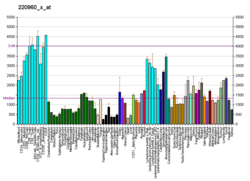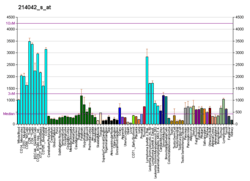60S ribosomal protein L22
60S ribosomal protein L22 is a protein that in humans is encoded by the RPL22 gene on Chromosome 1.[5][6]
Function
Ribosomes, the organelles that catalyze protein synthesis, consist of a small 40S subunit and a large 60S subunit. Together these subunits are composed of 4 RNA species and approximately 80 structurally distinct proteins. This gene encodes a cytoplasmic ribosomal protein that is a component of the 60S subunit. The protein belongs to the L22E family of ribosomal proteins. Its initiating methionine residue is post-translationally removed. The protein can bind specifically to Epstein–Barr virus-encoded small RNAs (EBERs) 1 and 2. The mouse protein has been shown to be capable of binding to heparin. Transcript variants utilizing alternative polyA signals exist. As is typical for genes encoding ribosomal proteins, there are multiple processed pseudogenes of this gene dispersed through the genome. It was previously thought that this gene mapped to 3q26 and that it was fused to the acute myeloid leukemia 1 (AML1) gene located at 21q22 in some therapy-related myelodysplastic syndrome patients with 3;21 translocations; however, these fusions actually involve a ribosomal protein L22 pseudogene located at 3q26, and this gene actually maps to 1p36.3-p36.2.[6]
Together with RPL4, RPL22 forms the narrowest constriction of the ribosomal exit tunnel (the grove through which a growing protein chain exits the ribosome), and consequently mutations in RPL22 are believed to alter the efficiency with which protein synthesis proceeds.[7]
Insects
The gene may play a role in Insect toxicity resistance. In culex mosquitos, it was one of several ribosomal proteins which were overexpressed in strains resistant to the insecticide deltamethrin.[8] More focused analysis revealed that resistant mosquitoes expressed RPL22 at a level more than 2.5x higher than susceptible strains; however, the same study found that over-expression of RPL22 in transfected cells caused a down-regulation of a different deltamethrin-resistance gene (CYP6A1) and made these cells overall less resistant to the insecticide.[9] Less ambiguously, multiple studies indicate that mutations in RPL22 confer erythromycin resistance on E. coli bacteria.[10][11]
References
- 1 2 3 GRCh38: Ensembl release 89: ENSG00000116251 - Ensembl, May 2017
- 1 2 3 GRCm38: Ensembl release 89: ENSMUSG00000028936 - Ensembl, May 2017
- ↑ "Human PubMed Reference:".
- ↑ "Mouse PubMed Reference:".
- ↑ Nucifora G, Begy CR, Erickson P, Drabkin HA, Rowley JD (August 1993). "The 3;21 translocation in myelodysplasia results in a fusion transcript between the AML1 gene and the gene for EAP, a highly conserved protein associated with the Epstein-Barr virus small RNA EBER 1". Proceedings of the National Academy of Sciences of the United States of America. 90 (16): 7784–8. doi:10.1073/pnas.90.16.7784. PMC 47227. PMID 8395054.
- 1 2 "Entrez Gene: RPL22 ribosomal protein L22".
- ↑ Nakatogawa H, Ito K (2002). "The ribosomal exit tunnel functions as a discriminating gate". Cell. 108 (5): 629–36. doi:10.1016/S0092-8674(02)00649-9. PMID 11893334.
- ↑ Wu H, Tian H, Wu G, Langdon G, Kurtis J, Shen B, Ma L, Li X, Gu Y, Hu X, Zhu C (July 2004). "Culex pipiens pallens: identification of genes differentially expressed in deltamethrin-resistant and -susceptible strains". Pesticide Biochemistry and Physiology. 79 (3): 75–83. doi:10.1016/j.pestbp.2004.04.004.
- ↑ He J, Sun H, Zhang D, Sun Y, Ma L, Chen L, Liu Z, Xiong C, Yan G, Zhu C (June 2009). "Cloning and characterization of 60S ribosomal protein L22 (RPL22) from Culex pipiens pallens". Comparative Biochemistry and Physiology. Part B, Biochemistry & Molecular Biology. 153 (2): 216–22. doi:10.1016/j.cbpb.2009.03.003. PMID 19298862.
- ↑ Chittum HS, Champney WS (1994). "Ribosomal protein gene sequence changes in erythromycin-resistant mutants of Escherichia coli". Journal of Bacteriology. 176 (20): 6192–8. PMC 196958. PMID 7928988.
- ↑ Gabashvili IS, Gregory ST, Valle M, Grassucci R, Worbs M, Wahl MC, Dahlberg AE, Frank J (2001). "The polypeptide tunnel system in the ribosome and its gating in erythromycin resistance mutants of L4 and L22". Molecular Cell. 8 (1): 181–8. doi:10.1016/S1097-2765(01)00293-3. PMID 11511371.
Further reading
- Wool IG, Chan YL, Glück A (1996). "Structure and evolution of mammalian ribosomal proteins". Biochemistry and Cell Biology = Biochimie Et Biologie Cellulaire. 73 (11–12): 933–47. doi:10.1139/o95-101. PMID 8722009.
- Toczyski DP, Steitz JA (February 1991). "EAP, a highly conserved cellular protein associated with Epstein-Barr virus small RNAs (EBERs)". The EMBO Journal. 10 (2): 459–66. PMC 452667. PMID 1846807.
- Fujita Y, Okamoto T, Noshiro M, McKeehan WL, Crabb JW, Whitney RG, Kato Y, Sato JD, Takada K (March 1994). "A novel heparin-binding protein, HBp15, is identified as mammalian ribosomal protein L22". Biochemical and Biophysical Research Communications. 199 (2): 706–13. doi:10.1006/bbrc.1994.1286. PMID 8135813.
- "Toward a complete human genome sequence". Genome Research. 8 (11): 1097–108. November 1998. doi:10.1101/gr.8.11.1097. PMID 9847074.
- Le S, Sternglanz R, Greider CW (March 2000). "Identification of two RNA-binding proteins associated with human telomerase RNA". Molecular Biology of the Cell. 11 (3): 999–1010. doi:10.1091/mbc.11.3.999. PMC 14826. PMID 10712515.
- Shu-Nu C, Lin CH, Lin A (October 2000). "An acidic amino acid cluster regulates the nucleolar localization and ribosome assembly of human ribosomal protein L22". FEBS Letters. 484 (1): 22–8. doi:10.1016/S0014-5793(00)02118-9. PMID 11056215.
- Uechi T, Tanaka T, Kenmochi N (March 2001). "A complete map of the human ribosomal protein genes: assignment of 80 genes to the cytogenetic map and implications for human disorders". Genomics. 72 (3): 223–30. doi:10.1006/geno.2000.6470. PMID 11401437.
- Andersen JS, Lyon CE, Fox AH, Leung AK, Lam YW, Steen H, Mann M, Lamond AI (January 2002). "Directed proteomic analysis of the human nucleolus". Current Biology. 12 (1): 1–11. doi:10.1016/S0960-9822(01)00650-9. PMID 11790298.
- Yoshihama M, Uechi T, Asakawa S, Kawasaki K, Kato S, Higa S, Maeda N, Minoshima S, Tanaka T, Shimizu N, Kenmochi N (March 2002). "The human ribosomal protein genes: sequencing and comparative analysis of 73 genes". Genome Research. 12 (3): 379–90. doi:10.1101/gr.214202. PMC 155282. PMID 11875025.
- Andersen JS, Lam YW, Leung AK, Ong SE, Lyon CE, Lamond AI, Mann M (January 2005). "Nucleolar proteome dynamics". Nature. 433 (7021): 77–83. doi:10.1038/nature03207. PMID 15635413.
- Chen KC, Chiang HS, Fang CL (2005). "EBER expression of pure urinary bladder lymphoepithelioma-like carcinoma in two unique Asian patients". Urologia Internationalis. 74 (3): 280–2. doi:10.1159/000083565. PMID 15812220.
- Fok V, Mitton-Fry RM, Grech A, Steitz JA (May 2006). "Multiple domains of EBER 1, an Epstein-Barr virus noncoding RNA, recruit human ribosomal protein L22". Rna. 12 (5): 872–82. doi:10.1261/rna.2339606. PMC 1440895. PMID 16556938.
- Nakao K, Mochiki M, Nibu K, Sugasawa M, Uozaki H (April 2006). "Analysis of prognostic factors of nasopharyngeal carcinoma: impact of in situ hybridization for Epstein-Barr virus encoded small RNA 1". Otolaryngology–Head and Neck Surgery. 134 (4): 639–45. doi:10.1016/j.otohns.2005.11.022. PMID 16564389.






